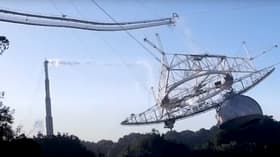| Imaginile cu neutroni dezvăluie zincul ca fiind vinovat în prăbușirea radiotelescopului Arecibo |
 |
 |
| Duminică, 27 August 2023 19:18 |
|
Almost three years after the event, neutron scans by the Oak Ridge National Laboratory have uncovered the cause of the platform collapse that resulted in the destruction of the 1,000-ft (300-m) Arecibo Observatory radio telescope.
Constructed in 1963, The Arecibo radio telescope was constructed in a natural sinkhole, with a 1.8-million-lb (816,000-kg) steel platform suspended at the focus point 500 ft (150 m) above the mesh dish. For over 50 years it performed cutting-edge astronomical research, beamed one of the first messages into space in an attempt to contact alien civilizations, and was the setting for the climax for the 1995 Bond thriller GoldenEye.
Then, on December 1, 2020, this all came to an end when the support cables suddenly slipped, sending the massive platform crashing into the dish – fortunately, without any casualties. After a thorough study, it was determined that the damage was so extensive and would be so expensive to repair that the decision was made to scrap the telescope.
As part of this effort, Adrian Brügger, director of Columbia University’s Robert A. W. Carleton Strength of Materials Laboratory, took whole sections of the failed cable sockets, complete with cables and socket liners, and subjected them to neutron scans at Oak Ridge's High Flux Isotope Reactor (HFIR). Neutron scanning is commonly used for a number of applications because of its high penetrating power and the fact that neutrons interact with matter differently from more conventional X-rays. Where X-rays attenuate because of the density of the matter they pass through, neutrons non-destructively interact with the matter and scatter in ways that allow the scan to both make a detailed image of a bank vault lock and the structure of a frog's muscles.
In the case of Arecibo, the scans allowed Brügger to make cross section images of the cable sockets and determine which cables slipped and by how much, even if they were still buried inside the zinc lining. What became apparent was that as cables were subject to the stress of supporting the platform they began to fray. This, in turn, caused the zinc to flow under the tension. Eventually, the zinc flowed so much that the sockets failed and the cables were pulled out entirely.
* * *-- Source: ORNL
|
























